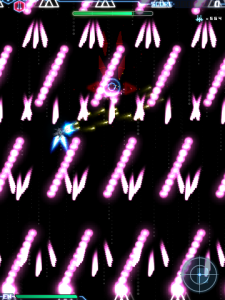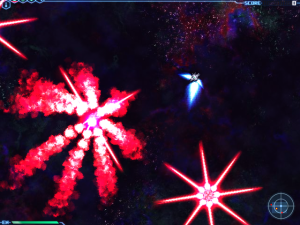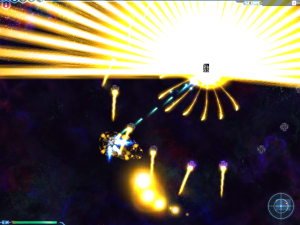
Official Site (Japanese) || Fraxy HQ
Fraxy is a shmup dedicated to boss fights, but it is also a powerful and flexible engine dedicated to making those fights. With a small yet dedicated fanbase, Fraxy has amassed quite a large amount of user-created content over the years and we’ll be taking a look at some of these creations in the very near future. For now, this article will serve as an introduction to Fraxy both as a game and as an engine.
As a game, this one has some pretty significant changes from most shmups, though these changes largely serve to give the player freedom in choosing how they want to play. Getting into the details of customization right away would likely just be confusing, so I’m going to start with the basics. You control a ship and fight bosses, either random ones from your collection or bosses of your choice; you can even set later bosses to increase in ‘rank’ as you go along to boost their difficulty, though most bosses are admittedly made with a fixed difficulty in mind. Bosses are made of multiple parts, sometimes hundreds, and can be highly destructible, but the ultimate objective is to, in the immortal words of Gradius, shoot the core enough to make the whole thing explode. In fact, anything in this game can potentially be explosive to the point that you can destroy a core or other parts of a boss with damage with damage from another part’s explosion. You have infinite lives and, unlike in most shmups, you do not die in one hit and instead have an Energy Meter. This meter is particularly unique in that it is not merely used as health, but also to power boosting and some weapons. By default you can shoot a weapon with the left mouse button and speed up with a boost with the right mouse button, but boosting and certain weapons drain energy, making you more vulnerable to enemy fire. The Energy Meter itself gradually refills and creates a balance between conserving energy to withstand a few hits from smaller attacks and consuming energy to maneuver quickly and to fire your strongest weapons. It’s also worth noting that, since Fraxy uses both the mouse and keyboard, your ship’s direction is not locked and you can freely turn and fire anywhere you want. This freedom of movement ties in with what is one of the most crucial bits of player customization – the play area itself.
 As an engine, Fraxy has to allow for flexibility and being able to adjust the play area itself is a particularly unusual aspect of this versatile nature. The ‘area fixed mode’ option allows players to choose between two styles of play which I will be referring to as ‘free’ and ‘fixed’ for the sake of clarity. In free mode the camera follows the player as you are free to move as you please and radar shows the general position of the boss. Bosses will automatically despawn if the distance between their central core and the player becomes too large, but this mode is useful for very large or otherwise mobile enemies. Fixed mode is for more standard fights as the camera is locked in place and the player cannot leave its bounds, allowing for fights against bosses with carefully-crafted attack patterns or against immobile bosses which otherwise would be too easy to pick off from afar. One thing to be aware of is changing the game’s resolution will also change the size of the arena for fixed mode, so it can take a few attempts to figure out if a boss is designed for free or fixed play and which resolution it was intended to be fought in.
As an engine, Fraxy has to allow for flexibility and being able to adjust the play area itself is a particularly unusual aspect of this versatile nature. The ‘area fixed mode’ option allows players to choose between two styles of play which I will be referring to as ‘free’ and ‘fixed’ for the sake of clarity. In free mode the camera follows the player as you are free to move as you please and radar shows the general position of the boss. Bosses will automatically despawn if the distance between their central core and the player becomes too large, but this mode is useful for very large or otherwise mobile enemies. Fixed mode is for more standard fights as the camera is locked in place and the player cannot leave its bounds, allowing for fights against bosses with carefully-crafted attack patterns or against immobile bosses which otherwise would be too easy to pick off from afar. One thing to be aware of is changing the game’s resolution will also change the size of the arena for fixed mode, so it can take a few attempts to figure out if a boss is designed for free or fixed play and which resolution it was intended to be fought in.
It probably comes as no surprise that your ship itself has several options to choose from. Though you can’t change your ship’s hitbox, you can choose between several different ‘types’, such as the BulletHell, which dies in one hit from anything while using virtually no energy when boosting or using most weapons, and the Deadlocker, which starts with high stats and doesn’t benefit from upgrades dropped by boss cores. You can also choose from well over a dozen different weapons and utility abilities to place in up to five slots, though if balance is a concern you may want to be careful as some of these can easily break certain fights, such as the Blaster with its ability to deal splash damage through walls.
Other than the ship, all sorts of little things can be customized. There are several built-in backgrounds to choose from and you can add your own and even adjust the scroll speed and direction. There is no built-in music so you need to supply your own and choose how frequently tracks cycle. You can’t change your hitbox, but you can change the look of your ship and even the general aesthetic of the enemies themselves if you make or download the right files to do so. Even things like bullet color and if bosses spawn at a specific position or randomly can be changed; this is a game which wants to give players at least as much control over their experiences as the creators of those experiences. On a final note before getting into the editor itself, content for ‘Try’ mode also exists, though it is less common, and this content does lock in virtually everything from the background to the play area, though the player’s ship is excluded, and can limit the number of lives the player has, set a time limit, or require the player to fight multiple bosses in a row; it’s a more limiting mode, but it does add an additional layer of challenge and can result in some pretty impressive handcrafted experiences.

Okay, I’ve rambled about playing the game for long enough, let’s get to the heart of Fraxy, the editor itself. This editor can be pretty overwhelming to look at compared to ones like the editor in Super Mario Maker and you really will probably need a guide or two if you plan to create an event-heavy fight filled with multiple phases and intricate bullet patterns, but the best way to learn how to use this editor is simply to play around with it a bit. There are over 50 parts in terms of weaponry alone and this number increases to well over 100 when you include cores, joints, visual effects, walls, and various bits labelled as ‘decorations’, though you are only allowed to pick a core at the start. This is an editor which relies entirely upon parent/child systems, which may sound scary and confusing to those unfamiliar with programming, but it basically means that every part other than the initial core (which is only a parent) is a ‘child’ attached to a ‘parent’ part – if the parent part is destroyed the child parts will go with it and a part’s general location and orientation is relative to those of its parent. Once you choose a core to start with, you can rapidly continue to add parts to it to and test it at any time to see how it looks and how everything behaves. Using the editor is a constant learning process, but you can spend hours carefully adjusting a boss or whip together a messy, though perfectly functional, encounter in a handful of minutes.
Placing parts wherever you want and linking certain parts to each other is all well and good, but the true power of the editor lies within the parts themselves. The number of options you have at your disposal when it comes to modifying individual parts is outright astonishing. The health of any given part can be changed to anything you desire and parts can even be made entirely invincible by making this value -1. Parts can be marked as ‘shadowed’ to make them appear as background elements, which is extremely useful when it comes to making cool-looking bosses or for having parts attack from certain locations without getting in the way of the player and projectiles. An option to make parts ‘hidden’ also exists for if you still want a part to do whatever its function is without actually being visible, which is primarily an aesthetic choice for when you want to launch attacks from multiple locations without crowding up the screen with the parts themselves. If a part is capable of movement, you usually have multiple options specifically designed for that part to choose from to adjust its movement pattern or its speed and you can always make a part immobile. Weapons also almost always have multiple options to select from for their attacks, which often affect the size or duration of their attacks, and the starting frame of any given piece can also be manually adjusted to stagger these attacks (ex: setting a weapon to start on frame 100 of its attack means there will be a 100 frame gap between when it and one with a default starting frame actually launch their attacks). With an arsenal consisting not only of the standard lasers and spread guns, but also homing attacks, bubbles, gravity wells, thrusters, laser swords, and a whole bunch of other cool stuff, all of this alone is already enough to make a fantastic fight, but I haven’t even talked about events yet.

Events can allow you to make multi-phase boss fights, timed occurrences, and intricate attacks and are something you will almost certainly want to avoid so much as touching until you feel comfortable with the other parts of the editor. Each part can have several events and these are a bit closer to the realm of actual programming than the rest of the editor as they deal with things like variable manipulation and state checking. I don’t want to go too deeply into the specifics of how events work as a dedicated guide would be best for that and they can get complicated enough that there are still plenty of elements which I have not so much as touched despite spending quite a few hours with this editor, but I do want to at least give some examples of what they can do. For instance, you can set the main core of a boss to be invincible or otherwise impossible to attack until one or more other cores have been destroyed. If you want to create a sense of foreboding, you can have inactive shadowed parts pop out of the background and start attacking once another part takes enough damage. Separating a child from its parent part, destroying one part alongside another, simultaneously changing the movement and attack patterns of multiple parts, and nearly anything else you could possibly want to occur during your boss fight can be done with events. If you are willing to put in the time and effort, Fraxy’s editor is easily one of the strongest editors out there when it comes to making user-created content and it has enough layers that you can do anything from tossing out a boss in a handful of minutes to spending many hours fine-tuning a single creation.
That’s all I have to say about Fraxy for now, but you can expect to see articles covering user-created content from this and other games later this week and far into the future. As it stands, Fraxy offers up an extremely impressive amount of customization for players and creators alike and has only continued to improve as time goes on.